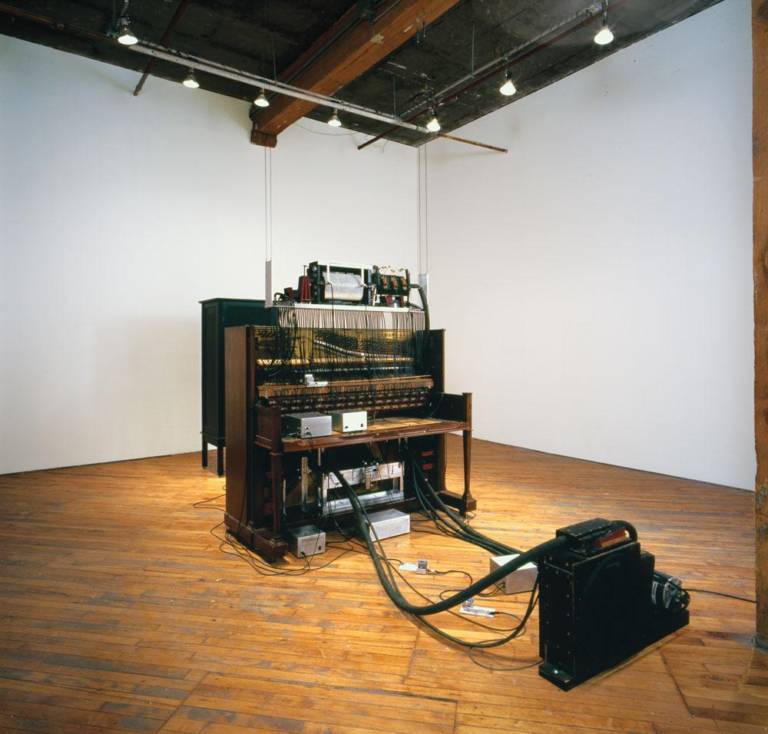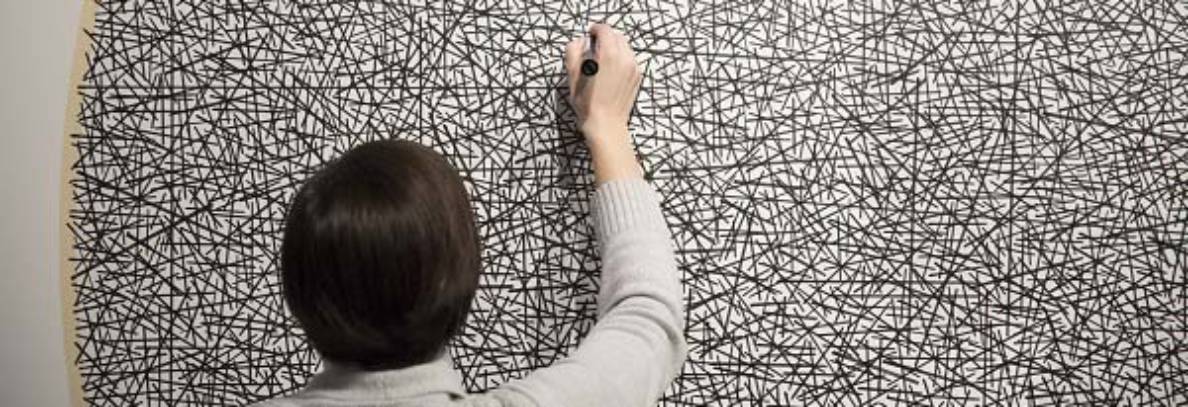Marla Hlady is a celebrated sound artist and kinetic sculptor. Her pieces deal with the nature of sound, often materializing it for viewers and reorienting their connection to everyday auditory experiences. Hlady received a BFA from the University of Victoria and an MFA from York University. She began showing in the early 1990s, eventually being included in several national and international group shows, such as 1996’s “Blink” at Toronto’s Power Plant. (In 2001, the same gallery hosted a solo show of her work.) Hlady’s practice developed in scope and ambition through the 2000s; 2008’s Playing Piano was a player piano from the 1920s intricately modified with contemporary machinery. In 2012, Hlady did a number of site-specific projects for her solo show at Hallwalls in Buffalo, New York, and for a residency in Norway. Hlady was nominated for the 2002 Sobey Art Award and her work is in the collections of the Art Gallery of Ontario and the National Gallery of Canada.

(video at links)
Playing Piano is a partially deconstructed upright player piano prepared in the spirit of John Cage. This fully mechanized 1920’s player piano is animated by a motor and pneumatics (as opposed to being played by a person). A perforated paper roll, the physical translation of the musical score, controls the mechanized elements. The preparations to Playing Piano include various machines which strum and press a pie plate against the strings, whistle using the air of the pneumatics and amplify various parts of the piano’s mechanics. An array of sensors placed on the strings in conjunction with a computer and a series of microprocessors, enables the player piano to control these preparations.

A Case for Sound, 2009 (Ongoing)
A Case for Sound is a sound object made to look somewhere between a suitcase/carrying case, record album box, instrument and portable record player. The object is constructed with wood and finished to a high gloss, holes are cut in each side for the speakers. Inside an MP3 player loops an audio segment. Each sound work composed for the cases is made up of as many as 8 segments–each case plays one looping segment. A motion switch interrupts the audio when the object is tilted. If repeatedly tilted, the interrupted audio can sound similar to a skipping record.

Second Floor Window Fill, 2011
Second Floor Window Fill was part of the solo exhibition Rooms at Oakville Galleries Gairloch Gardens exhibition space, a site-related collection of works.
The average square footage of the rooms on the second floor is calculated. This square footage is then reduced to a shape that fits the gallery window; the ratio is 1:4.5. Second Floor Window Fill consists of all of the rooms’ volumes on the second floor added together then reduced using the 1:4.5 ratio (1 inch = 4½ inches).
All of the sounds of the rooms on the second floor are edited to a proportion that relates to the size of the room they were recorded in. These sound clips are then strung together consecutively; the clips fade in and out of each other.

Walls was produced as part of Hallwalls’ Artist in Residency Program (HARP)
Two of Hallwalls’ moveable walls have been reduced to approximately 1:5 scale and then re-imagined as machines. In the scale model version, one wall now turns a full 360 degrees and plays a hip-hop record backwards. Both the record and the machine’s platform are amplified and heard through two speakers placed in proximity to the machine. The other wall, now paper, rolls back and forth via a lever-like movement. As the wall dips down, it at times bangs and at other times brushes amplified strings. The sound from this machine is heard from 2 other speakers, also placed proximally.

Soundball (Dancehauling), 2013
Soundball (Dancehauling) is an instrument/sculpture that viewers can manipulate as a way to play with sound compositions. The sounds, developed in collaboration with musician Eric Chenaux, deconstruct the rhythm and melody relationship of traditional dance music (jigs, reels, slipjigs or hornpipes to use examples from Irish, Scottish and English traditional music) wherein the musician uses his/her beating foot to ground the often sinuous or meandering melody as a rhythmic aid for the dancer. Here the performance/recording of both the foot beat (Hlady) and the bowed guitar (Chenaux) have been made independently. Each sound is now in its own ball ready to be played, separately or in unison. Previous iterations of this sculpture include a smaller version produced as an artist multiple (Soundball 4) and a percussion instrument used for music performances (Marla Hlady and The Tristanos)
